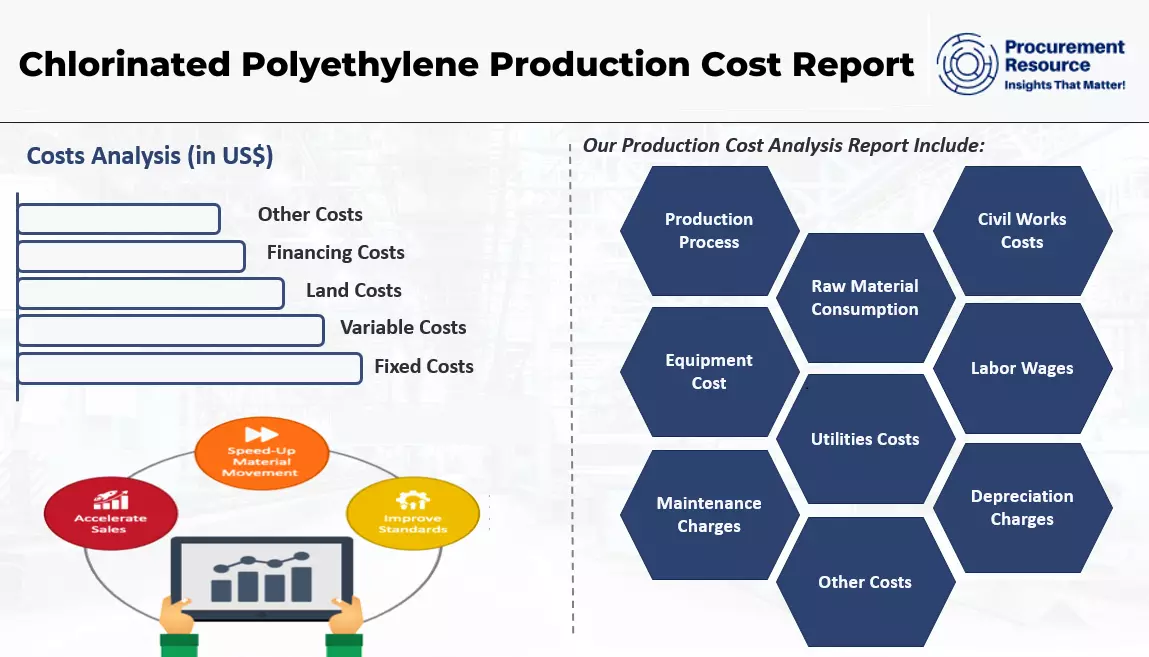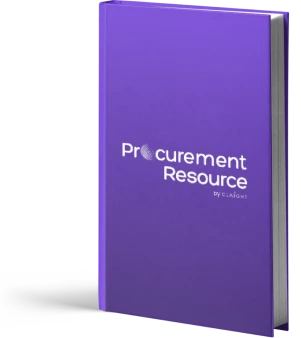Chlorinated Polyethylene Production Cost Reports
Chemicals
The report provides a detailed analysis essential for establishing a Chlorinated Polyethylene manufacturing plant. It encompasses all critical aspects necessary for Chlorinated Polyethylene production, including the cost of Chlorinated Polyethylene production, Chlorinated Polyethylene plant cost, Chlorinated Polyethylene production costs, and the overall Chlorinated Polyethylene manufacturing plant cost. Additionally, the study covers specific expenditures associated with setting up and operating a Chlorinated Polyethylene production plant. These encompass manufacturing processes, raw material requirements, utility requirements, infrastructure needs, machinery and technology requirements, manpower requirements, packaging requirements, transportation requirements, and more.

Chlorinated Polyethylene is a thermoplastic material that is derived from polyethylene through a chlorination process that makes it more versatile. CPE exhibits excellent chemical resistance properties, including resistance to thermal aging, oxygen, ozone, acids, and alkalis. It is versatile and can be blended with other thermoplastic materials such as polyethylene, polypropylene, polystyrene, and ABS to meet specific application requirements. CPE is recognized as a high-quality rubber material and is often used to modify other rubber types.
The combination of CPE with other materials is commonly utilized in the production of a wide range of products, including wires, cables, hydraulic hoses, tapes, automotive hoses, plastic bags, and plastic sheets. It is also used in manufacturing waterproofing membranes, thermal insulation materials, flooring materials, and pipe seals. It also finds its application in the production of certain medical devices, such as medical gloves and tubing, seals.
Chlorinated polyethylene exhibits several key characteristics that drive its global market demand. Its unique properties of chemical resistance, flexibility, oil resistance, and flame-retardant nature make it a sought-after commodity among multiple industries. Its application as a component in manufacturing hydraulic hoses, automotive hoses, wires, and cables further enhances its demand in the electronic and automotive industries. Its utilization in the production of flexible tubing, blood bags, dialysis machine parts, and tubing seals largely promotes its demand in the medical sector.
Its utilization in manufacturing thermal insulation materials, waterproofing membranes, and various plastic products also fuels its demand in the construction and building materials, and plastic industries. Industrial Chlorinated Polyethylene procurement is primarily influenced by its demand as a high-quality rubber material in the rubber industry. Moreover, its applications in the rubber and plastics industries, the cost and the availability of raw materials (chlorine, etc.), regulatory compliance, and sustainability practices also affect its procurement.
Raw Material for Chlorinated Polyethylene Production
According to the Chlorinated Polyethylene manufacturing plant project report, the major raw materials for Chlorinated Polyethylene production include Polyethylene (PE) Powder-Chlorine Gas.
Manufacturing Process of Chlorinated Polyethylene
The extensive Chlorinated Polyethylene production cost report consists of the following industrial manufacturing process:
- Production from Aqueous Phase Method: In this method, chlorinated polyethylene is synthesized as a product by using the process of aqueous phase method. The process is initiated by dispersing the polyethylene (PE) powder in the aqueous phase medium, followed by the introduction of chlorine gas to chlorinate the polyethylene, which leads to the formation of chlorinated polyethylene as the final product.
Chlorinated Polyethylene appears as a white or slightly off-white powder and can have varying densities depending on its chlorine content, generally around 0.93 to 1.1 g/cm3. The molecular formula of the compound is C4H7Cl, and the molecular mass of the compound is 90.55 g/mol. The melting point of the compound is between 120-150 °C. CPE is produced by the substitution of hydrogen atoms with chlorine atoms in high-density polyethylene (HDPE).
The addition of chlorine significantly alters the properties of the original polyethylene. The material's elasticity tends to increase with higher chlorine content. CPE exhibits excellent chemical resistance properties, including resistance to thermal aging, oxygen, ozone, acids, and alkalis. While CPE itself is generally considered non-toxic, it's important to handle and use it in accordance with safety standards.
Chlorinated Polyethylene Production Cost Processes with Cost Analysis

Chlorinated Polyethylene Production by the Aqueous Phase Production Process
This study analyzes Chlorinated Polyethylene Production by the Aqueous Phase Production Process, covering manufacturing, process flow, operating expenses, and financial considerations.
Details: Germany - based plant Q1 2025 From $ 2499.00 USD
Product Details
| Particulars | Details |
|---|---|
| Product Name | Chlorinated Polyethylene |
| Scope | Manufacturing Process: Process Flow, Material Flow, Material Balance Raw Material and Product Specifications: Raw Material Consumption, Product and Co-product Generation Land and Site Cost: Offsites/Civil Works, Equipment Cost, Auxiliary Equipment Costs, Contingency, Engineering and Consulting Charges, Working Capital Variable Cost: Raw Material, Utilities, Other Variable Costs Fixed Cost: Labor Requirements and Wages, Overhead Expenses, Maintenance Charges, Other Fixed Costs Financing Costs: Interest on Working Capital, Interest on Loans Other Costs: Depreciation Charges, General Sales and Admin Cost |
| Currency | US$ (Data can also be provided in the local currency) |
| Pricing and Purchase Options | Basic: US$ 2499 Premium: US$ 3499 Enterprise: US$ 4799 |
| Customization Scope | The report can be customized as per the requirement of the customer |
| Post-Sale Analysts Report | 10-12 weeks of post-purchase analyst support after report delivery for any queries from the deliverable |
| Delivery Format | PDF and Excel format through email (editable version in PPT/Word format of the report can be also provided on special request) |
How does our Chlorinated Polyethylene Production Cost Report Provide Exhaustive Data and Extensive Insights?
At Procurement Resource, we not only focus on optimizing the should cost of production for Chlorinated Polyethylene but also provide our clients with extensive intel and rigorous information on every aspect of the production process. By utilizing a comprehensive cost model, we help you break down expenses related to raw materials, labor, and technology, offering clear pathways to savings. We also assist in evaluating the capital expenditure (CAPEX) and operating expenses (OPEX), which are often measured as cost per unit of production, such as USD/MT, ensuring that your financial planning is aligned with industry benchmarks.
We offer valuable insights on the top technology providers, in-depth supplier database, and best manufacturers, helping you make informed decisions to improve efficiency. Additionally, we design the most feasible layout for your production needs, ensuring the entire process runs smoothly. By minimizing the cash cost of production, we ensure that you stay competitive while securing long-term profitability in the growing Chlorinated Polyethylene market. Partnering with Procurement Resource guarantees that every aspect of your production is cost-efficient, advanced, and tailored to your specific requirements.
Key Questions Answered in This Report
- What are the key requirements for setting up a Chlorinated Polyethylene manufacturing plant?
- How is Chlorinated Polyethylene manufactured?
- What is the process flow involved in producing Chlorinated Polyethylene?
- What are the raw material requirements and costs for producing Chlorinated Polyethylene?
- What is the total size of land required for setting up a Chlorinated Polyethylene manufacturing plant?
- What are the construction requirements for setting up a Chlorinated Polyethylene manufacturing plant?
- What are the machinery requirements for producing Chlorinated Polyethylene?
- What are the utility requirements and costs for producing Chlorinated Polyethylene?
- What are the manpower requirements for producing Chlorinated Polyethylene?
- What are the average salaries/wages of manpower working in a Chlorinated Polyethylene manufacturing plant?
- What are the packaging requirements and associated costs for Chlorinated Polyethylene?
- What are the transportation requirements and associated costs for Chlorinated Polyethylene?
- What are the capital costs for setting up a Chlorinated Polyethylene manufacturing plant?
- What are the operating costs for setting up a Chlorinated Polyethylene manufacturing plant?
- What should be the price of Chlorinated Polyethylene?
- What will be the income and expenditures for a Chlorinated Polyethylene manufacturing plant?
Need more help?
- We can tailor the report as per your unique requirements such as desired capacity, future expansion plans, product specifications, mode of financing, plant location, etc.
- We can also provide a flexible, easy-to-use, dynamic excel-based cost-model/ dashboard where you can change the inputs to get different outputs
- Speak to our highly skilled team of analysts for insights on the recent trends and innovations, industry best practices, key success and risk factors, product pricing, margins, return on investment, industry standards and regulations, etc.
- Gain an unparalleled competitive advantage in your domain by understanding how to optimize your business operations and maximize profits
- For further assistance, please connect with our analysts
Compare & Choose the Right Report Version for You

You can easily get a quote for any Procurement Resource report. Just click here and raise a request. We will get back to you within 24 hours. Alternatively, you can also drop us an email at sales@procurementresource.com.
RIGHT PEOPLE
At Procurement Resource our analysts are selected after they are assessed thoroughly on having required qualities so that they can work effectively and productively and are able to execute projects based on the expectations shared by our clients. Our team is hence, technically exceptional, strategic, pragmatic, well experienced and competent.
RIGHT METHODOLOGY
We understand the cruciality of high-quality assessments that are important for our clients to take timely decisions and plan strategically. We have been continuously upgrading our tools and resources over the past years to become useful partners for our clientele. Our research methods are supported by most recent technology, our trusted and verified databases that are modified as per the needs help us serve our clients effectively every time and puts them ahead of their competitors.
RIGHT PRICE
Our team provides a detailed, high quality and deeply researched evaluations in competitive prices, that are unmatchable, and demonstrates our understanding of our client’s resource composition. These reports support our clientele make important procurement and supply chains choices that further helps them to place themselves ahead of their counterparts. We also offer attractive discounts or rebates on our forth coming reports.
RIGHT SUPPORT
Our vision is to enable our clients with superior quality market assessment and actionable evaluations to assist them with taking timely and right decisions. We are always ready to deliver our clients with maximum results by delivering them with customised suggestions to meet their exact needs within the specified timeline and help them understand the market dynamics in a better way.
SELECT YOUR LICENCE TYPE
- Review the available license options and choose the one that best fits your needs. Different licenses offer varying levels of access and usage rights, so make sure to pick the one that aligns with your requirements.
- If you're unsure which license is right for you, feel free to contact us for assistance.
CLICK 'BUY NOW'
- Once you've selected your desired report and license, click the ‘Buy Now’ button. This will add the report to your cart. You will be directed to the registration page where you’ll provide the necessary information to complete the purchase.
- You’ll have the chance to review your order and make adjustments, including updating your license or quantity, before proceeding to the next step.
COMPLETE REGISTRATION
- Enter your details for registration. This will include your name, email address, and any other necessary information. Creating an account allows you to easily manage your orders and gain access to future purchases or reports.
- If you already have an account with us, simply log in to streamline the process.
CHOOSE YOUR PAYMENT METHOD
- Select from a variety of secure payment options, including credit/debit cards, PayPal, or other available gateways. We ensure that all transactions are encrypted and processed securely.
- After selecting your payment method, you will be redirected to a secure checkout page to complete your transaction.
CONFIRM YOUR PURCHASE
- Once your payment is processed, you will receive an order confirmation email from sales@procurementresource.com confirming the dedicated project manger and delivery timelines.
ACCESS YOUR REPORT
- The report will be delivered to you by the project manager within the specified timeline.
- If you encounter any issues accessing your report, project manager would remain connected throughout the length of the project. The team shall assist you with post purchase analyst support for any queries or concerns from the deliverable (within the remit of the agreed scope of work).
